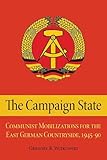The Campaign State : Communist Mobilizations for the East German Countryside, 1945–1990 / Gregory Witkowski.
Material type: TextPublisher: Ithaca, NY : Cornell University Press, [2021]Copyright date: ©2017Description: 1 online resource (279 p.) : 14 illustrationsContent type:
TextPublisher: Ithaca, NY : Cornell University Press, [2021]Copyright date: ©2017Description: 1 online resource (279 p.) : 14 illustrationsContent type: - 9781501757655
- 338.1/843109045 23
- HX280.5.A6 W58 2017
- online - DeGruyter
| Item type | Current library | Call number | URL | Status | Notes | Barcode | |
|---|---|---|---|---|---|---|---|
 eBook
eBook
|
Biblioteca "Angelicum" Pont. Univ. S.Tommaso d'Aquino Nuvola online | online - DeGruyter (Browse shelf(Opens below)) | Online access | Not for loan (Accesso limitato) | Accesso per gli utenti autorizzati / Access for authorized users | (dgr)9781501757655 |
Frontmatter -- Contents -- Abbreviations -- Illustrations -- Author's Note -- Acknowledgments -- INTRODUCTION Campaigns in Context -- Part One CAMPAIGNS AND STATE PLANNING -- CHAPTER ONE Out of Ruins? Creating an East German State, 1945-1952 -- CHAPTER Two State Planning in Action: Communist Campaigns in the Era of Collectivization, 1953-1961 -- CHAPTER THREE Recruiting the "Best Workers" -- CHAPTER FOUR Workers to the Countryside! -- Part Two RITUALIZATION OF CAMPAIGNS -- CHAPTER FIVE Reforms New Opportunities after the Berlin Wall -- CHAPTER SIX Campaigns in Honecker's Germany -- CONCLUSION Evaluating the Campaign State -- Notes -- Bibliography -- Index
restricted access online access with authorization star
http://purl.org/coar/access_right/c_16ec
Communist regimes are defined by dictatorial power, state planning, and active propaganda machines. In The Campaign State, Gregory Witkowski explores the intersection of these three elements in East Germany by focusing on mass mobilizations. He dissects the anatomy of campaigns and argues that while mass mobilizations are often perceived as symbols of strength, they also indicate underlying systemic weaknesses. By focusing on the ability of regimes to mobilize individuals to transform society, he explains both the durability and the ultimate demise of the German Democratic Republic. This study seamlessly blends an analysis of top-down campaign initiatives with the influence of such mobilizations on the grassroots level. For more than thirty years, East German leaders doggedly extended such mobilization efforts, yet complete success remained elusive. Witkowski reveals how local leaders, campaign participants, and peasants acted in ways both compliant and noncompliant with party goals to create societal change. Campaigns became a ubiquitous part of life under communist rule. Witkowski shows that such mobilizations were initially an integral part of state-planning efforts and only later became ritualized, as party portrayals of goals and accomplishments diverged from East Germans' lived experience. He argues that incessant campaigns exposed a substantial gap between rhetoric and reality in the German Democratic Republic that undermined the regime's legitimacy. This valuable and original study will appeal to scholars and students of German history, Communism, and state planning.
Mode of access: Internet via World Wide Web.
In English.
Description based on online resource; title from PDF title page (publisher's Web site, viewed 02. Mrz 2022)


